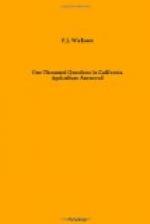Sewage Irrigation.
What is the usefulness or harmfulness of the outflow from septic tanks for use an fruits and vegetables?
There is no question as to the suitability of the affluent from a septic tank for irrigation purposes. Waste waters are sometimes injurious when they are loaded with antiseptics, but the septic tank will not work unless it has a chance for free fermentation in the absence of antiseptics, therefore, this objection against waste water does not hold with the out-flow from septic tanks. It has the advantage over straight sewage irrigation because fermentation in the septic tank is believed to free the water from many dangerous germs, though not all of them.
Creamery Wastes for Irrigation.
Will the waste water from a creamery, pumped into a ditch and used for irrigating sandy loam orchard land, or nursery stack, in any way be injurious to the land or the trees?
It will depend upon the amounts of salt and alkaline washing materials which it carries. This would be governed, of course, by the amount of fresh water used for dilution in the irrigation ditch. There are two ways to determine the question. One would be to make an analysis of a sample of the water taken when it contains the largest amount of these materials after the dilution with ditch water. Another way would be to plant some corn, squashes, barley and other plants, so that they would be freely irrigated by the water during one growing season. This would be rather better than an analysis, because everybody could see whether the plants grew well or not, and would be apt to be better convinced by what they see than by an opinion which a chemist might give on the basis of an analysis. The use of this water on a sandy loam would obviously be less injurious than upon a heavy retentive soil.
House Waste Water.
Is it feasible to use wash water, etc., for watering fruit trees and vegetables?
Kitchen sink water is not desirable because of its great content of grease, but wash-tub and bathtub water are good. Strong soapsuds should be mixed with considerable rinsing water to escape excessive content of alkali. Run the water in hoe-ditches, along the rows of vegetables, hoeing thoroughly as soon as the land hoes well, changing the runs of water so that the soil does not become compacted but is kept friable and lively.
Draining a Wet Spot.
I have a spot of about an acre that in a wet winter becomes very miry and as a rule is wet up to July. Can I put in a ditch two and one-half feet deep and fill in with small stones for a foot or a foot and a half, until I can afford to buy tiles?
Drains made of small stones are often quickly filled with soil and stop running. However, it will work for a time, and such drains were formerly largely employed in Eastern situations when cash was scant and stones abundant. Dig the ditch bottom to a depth of not less than 3 or 3 1/2 feet, then put in the stones deep enough not to be interfered with by plowing. If you have flat stones you can make quite a water-way with them and fill in with small stones above it.




